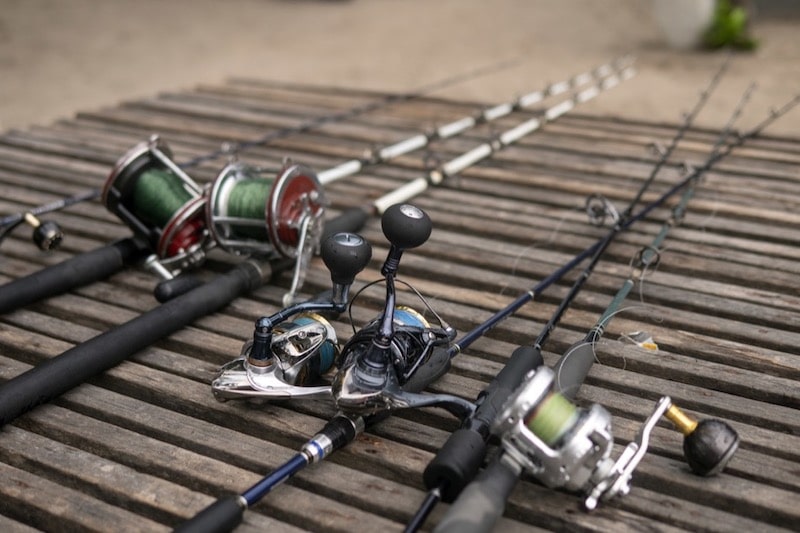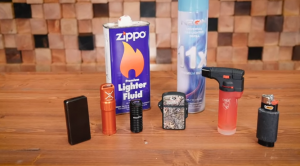Before you can think about slicing up a fish with your favorite fillet knife, you need to first catch the fish, and that require a rod and your favorite tackle box. In the world of many fishing rods, there is even more species of fish to catch. Some types of fish are smaller and weigh less than others, so they only require a lightweight fishing rod. There is a large variety of fishing rods on the market from which to choose. Certain types of fishing and the type of fish you want to catch can designate the best type of fishing rod for your particular situation. If you are after the lunkers in the large sizes, you will need a much sturdier rod to prevent it from breaking.
What We'll Cover
Different Types of Fishing Rods
An important note on fishing rods is the action or deflection, meaning the ability to bend. A fast action rod will only bend slightly at the tip. The moderate action rods bend up to one-third of the rod length and the fast action rods bend more than one-third of the length. This action or deflection is what happens when you hook a good-sized fish.
You should also understand the power or strength of fishing rods. They may be rated as heavy, medium and medium heavy. You should match your braided fishing line to your rod, so if you use a heavy rod, you need heavy line. If your rod and line are not matched, it can break your rod. Heavier rods work best for deep fishing and lighter rods are easier to cast.
Another option you will face when choosing the best fishing rod are the eyes on the rod. The eyes are the rings, which guide the string along your rod. The more eyes on your rod, the better it will cast and the more costly it will be, depending on the material they are made from. The rods with evenly spaced eyes along the entire length of the rod will ensure the strain on it is stretched along the entire length to allow you to catch larger fish with a better rod strength.
The end of the rod you hold onto is simply called the handle. The best material to look for on handles is cork. It gives you a great grip, even when wet, so it is not slippery like some other materials. Cork is also very lightweight, tends to feel good in your hand and balanced when you are casting a rod. There are different types of cork in different qualities and the price of the rod will reflect the type and quality of the cork handle.
Telescopic Rods
Telescopic fishing rods are compact and about one to two feet in length when they are pushed closed with the tip toward the handle. When you cast them, the tip of the rod extends out with your throw to about twenty feet long. These specialized rods are sometimes eyeless or guide less because the rod acts as the eyes with the line inside of it. It has a very flexible tip, much like a spinning rod and it’s very easy to handle. The most common fishermen to use telescopic rods are surf fisherman. They enjoy the easy folding design and small storage space needed for transportation when fishing.
Casting Rods
Casting rods are of two different types: the bait casting rod and the spin-casting rod. These rods are designed especially for accurate casting, so a fisherman can place the bait exactly where they want to lure the fish they want. The most modern rods don’t really differ very much. The eyes start close to the reel on your rod, and the spin-casting rod includes a forefinger trigger area to grasp your rod firmly. The eyes are generally small, with a larger eye next to the reel to work with spin casting reel efficiently.
Spinning Rods
Spinning rods are very similar to casting rods, except they are usually lighter and shorter in length. They do have larger eyes to reduce friction on the line when you are casting it. Spinning rods range in length from 4 to 9 feet long, and each has five to nine eyes on the rod. Casting reels are mounted on the top of the rods, and spinning reels are mounted on the underside of the rod. When the reel is on the underside, it gives you a more natural manner of fishing. Spinning rods are usually for younger fishermen, but they are also very popular with all fishermen.
Fly Rods
Fly rods are made in the most different sizes and shape of all fishing rods. They are specially made for fly fishing and are very flexible to allow casting forward and back several times while extending the line out for a cast. Fly rods are very light in weight and smaller compared to other types of rods. The variations in size allow you to catch the smallest trout in mountain streams or ponds, and also work to catch lake fish like tuna and marlin. Fly rods do not have a butt piece at the rear as others do; this enables great casting speed and casting the line freely. This, in combination with a specialized eye to curb tangles and heavy line, allows great strength and speed.
Ice Fishing Rods
Rods for going ice fishing are made shorter due to the fact you don’t have much space available when you ice fish. They are quite similar to a spinning rod and range in length from 25 to 37 inches long. They also have fewer eyes than a traditional spinning rod. Ice fishing rods do not use reels, but instead have two hooks across from each other to wind your line on them by hand when bringing your fish up from the water.
Surf Rods
This type of rod is very long and heavy duty to manage when fishing in the sea. Some may call them a sea rod, but this is a different category. The surf rod works best for heavy sinkers and for casting your bait at a long distance. They have a long handle at the rear with space for two-handed casts. They are an extended and heavier rod than a spinning rod.
Trolling Rods
Trolling rods are designed to catch fish behind a moving boat. They are mainly used for large game fishing such as tuna and marlin. The best trolling rods are long and have a heavy build to support large fish with a fast action. Spinning rods perform pretty much in the same manner, but they are usually not heavy enough to use as a trolling rod.
Pen Rods
Pen rods are very small to allow them the maximum of portability in a pocket of your coat or pants or in a small box. From the pen size, you can extend the rod out about 4 feet. Pen rods are the most lightweight rods you can find and they come in a large assortment of colors, sizes and qualities. This small rod is usually used for small and medium game fishes such as you would find in a lake.
Why Do Some Fish Need Special Rods?
Light and ultra-light rods are more geared to fishing for smaller fish species like pan fish and trout. The lighter weight has more bend in them and you can detect the bite of a smaller fish much easier. Moderate weight rods are great for reaction-based baits, like crank baits, jerk baits and spinner baits. Heavier weight rods are best for using top waters, frogs and jigs as they require less bend in your rod.
How to Select the Right Rod
To select the best rod for your particular situation, you should consider a few things. Where you will be fishing makes a difference, the species of fish you are trying to catch and what bait you want to use. From there, you can choose the model to best suit your needs. Then choose one with the right weight for the fish you want to catch and for your bait.
Freshwater fishing rods for pan fish and trout are generally ultra-light rods, so you can feel the slightest nibble on your line and set the hook quickly. To fish for bass in freshwater with a bass fishing rod, determine the kind of baits you will use. Consider a medium weight rod to use with spinner baits and swim jigs with single hooks. If you use crank baits, you will need a medium power rod to flex more when you hook the fish.
Saltwater fishing uses heavier rods and they come in corrosion-resistant materials. Your best onshore saltwater rods are usually lightweight spinning rods and will allow you to cast a long distance into the ocean. These rods are made from graphite or carbon fiber, so you get great sensitivity on bites from sheepshead and spotted sea trout. Offshore saltwater rods are made for big fish and heavy tackle secured with a pair of fishing pliers. They are shorter and stiffer than the onshore types, and come in different types depending on how you are fishing, such as vertical jigging, trolling or deep dropping.
You may instead decide on what type of fishing rod you want based on the reel type and bait you like best. The reel types are bait-casting reels, spinning reels, spin casting reels, fly-fishing reels, spinning fixed-spool reels, center pin reels and the open face-spinning reel. The spinning fixed spool reel is made for casting very light lures or artificial flies. The center pin reel allows you to cast great distances, and the bracket on it allows you to rotate it by up to 90 degrees for casting. The fly reel is quite simple: you strip the line off the reel with one hand and cast with the other while fly-fishing.
The bait-casting reel handles heavy fishing lines in different colors, lures and fish. The spin cast reel is often used by casual fishermen for small to medium-sized fish. It has a push button to release the line and cast and is enclosed on the top with one hole for the line to feed through. This type of reel is more often used by beginners and young anglers for its simplicity. The open face spinning reel comes in many sizes, so you can match the size to the size of the fish – from very small all the way to big game fish.
Conclusion
With so many fishing rods to choose from, you may find you want a few different types or weights in a particular type of rod. You will see many fishermen with a few rods and reels whenever they fish. This can be because they start out with a lightweight rod and reel and they are catching fish too big for it, so then they may change to a heavier weight rod and reel. Most beginners do best with just a lightweight rod and reel while they are learning, and then graduate up to better and more expensive models as they learn to fish.
The responses below are not provided, commissioned, reviewed, approved, or otherwise endorsed by any financial entity or advertiser. It is not the advertiser’s responsibility to ensure all posts and/or questions are answered.



![Best Archery Sets This 2023 [Men & Women]](/assets/images/8cf78150f1d9d7a0c175609145d21517.png)

